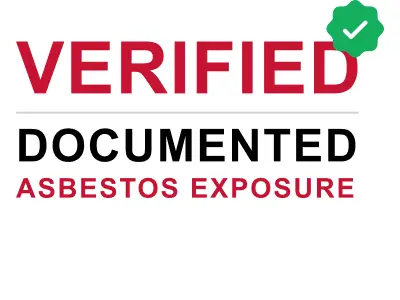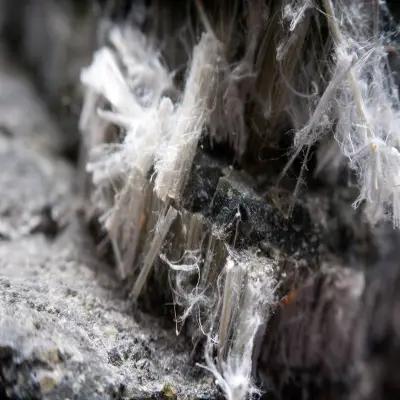Asbestos at Charleston Air Force Base
For over 31
years, Charleston Air Force Base in Charleston utilized asbestos extensively in various products.
Records from asbestos trust funds associated with Charleston Air Force Base show the use of products such as
pipe insulation and pipe coverings,
millboard, panelboard and misc. building materials,
raw asbestos fibers and misc.,
boiler and high-temp equipment insulation,
gaskets, packing and seals,
fireproofing materials and sprays,
flooring materials (tiles, sheet, adhesives),
joint compounds, insulating cements, adhesives and mastics,
roofing and siding shingles, coatings and sealants,
floor underlayments, backings and felts,
sprayed or trowled acoustic/decorative plasters and textures.
The following list contains asbestos products identified in claims against the
ACandS, Armstrong World Industries, Combustion Engineering, G-I Holdings asbestos
trust fund(s) linked to exposure at Charleston Air Force Base in Charleston, South Carolina:
ACandS
- 2000 Degree F. Block Insulation
- 27-B Soam Filler
- 85% Magnesia Block
- 85% Magnesia Cement
- 85% Magnesia Pipe Covering
- Accobest AN-8012
- Accobest AS-474 Gasketing Material
- Accobest AS-8073
- Accopac AD-8024 Asbestos Paper
- Acoustical Cements (306, 314/waterproof, 340/panel-board)
- Adhesives
- Aircell Block & Sheets
- Aircell Insulations
- Aircell Pipe Covering
- Amblerex
- Armabestos Pipe Covering and Block
- Armaglas Pipe and Duct Insulation
- Armalite
- Armaspray
- Armatemp Cement
- Armatemp No. 166 Cement
- Armatemp Pipe & Equipment Insulation
- Armflex Covering & Sheets
- Armflex Insulation
- Asbestos Ceiling Board
- Asbestos Cement
- Asbestos Felt
- Asbestos Floor Tiles
- Asbestos Insulating Cement
- Asphalt (Oil) Floor Tile
- Asphalt Putty
- Bestfelt Pipe Covering, Block and Sheets
- Box Toe
- Calcium Silicate Pipe Covering
- Cork Board
- Cork Pipe Covering
- Duplex Woolfelt Pipe Insulations
- Firebrick
- Gasket Material – Beater Saturated
- High Temp Block Insulation
- High Temp Cement
- High Temp Pipe Covering
- Hy-Temp Block
- Hy-Temp Cement
- Hy-Temp Pipe Covering
- Hydrocord Felt
- K&M Asbestos Insulating Cement Amblerex No. 2
- K&M Asbestos Insulating Cement Mineral Wool
- K&M Asbestos Insulating Cement No. 151
- K&M Asbestos Insulating Cement No. 152
- K&M Asbestos Insulating Cement Velvet Hard Finish
- K.P. Asbestos Floats
- Kamatt Pipe Covering
- Kaylo Pipe Covering and Block
- Kaylo-20
- Kaytherm Block
- Limpet Spray
- LK Pipe Covering
- LT Cork Covering
- LT Pipe Covering
- Mani-Ply Pipe Insulation
- Mastics
- Mattison
- Millboard
- Minalok
- Mineral Wool Cement
- Nesecone Ablation Material
- Non-Parell High Pressure Covering, Block and Cement2
- Other Cements
- Paper and Range Boiler Jackets
- Perforated/Unperforated Asbestos Cement Ceiling Board
- Plasticork
- Resurfacer
- Rollboard
- Roofing Materials
- Rubber Tile
- S-89
- S-90
- Sealers
- Simplex Pipe Insulations
- Sundries: Emulsions
- Temlok
- Tiles
- V-18 High Temperature Block
- Vinyl Asbestos Tile
Armstrong World Industries
- 314 Acoustic Cement
- Accobest Gasketing Material
- Accopac Asbestos Paper
- Armaspray
- Armaspray 16 Spray-on Insulation
- Armatemp Cement No. 10
- Asphalt Tile
- CC Navy Sealer
- Emulsions
- Excelon Tile
- Excelon Vinyl Asbestos Floor Tile
- Finishes
- FRJ
- Heavy Duty FRJ
- Heavy-Duty FRJ Insulation Jacket
- Hydrocord Flooring Felt
- LT Sealer
- LT – Cork Covering
- LT – Minus Thirty Cork Covering
- LT – Thirty Cork Covering
- LT – Zero Cork Covering
- Mastics
- Nonpareil High Pressure Cement
- Nonpareil High Pressure Covering Block
- Ring Facing Material
- Rubber Tile
- S-89 (Adhesive)
- S-89 Adhesive
- S-90 (Adhesive)
- S-90 Adhesive
- Sealers
- Sheet Gasketing Material
- Sprayed Limpet
- Vinyl Asbestos Tile
Combustion Engineering
- Block Stick
- Boilers
- Buck Stay Cement A- 1360
- Calcrete Insulating Cement
- Castablock Insulating Cement
- Expansion Joint Hat
- Fibrous Adhesive
- Gunisul
- Hilite Insulating Cement
- Kaiser Hard Top Insulating Cement
- Kaiser M Block Insulation
- Lite Wate 22
- Lite Wate 50
- MHD Finishing Cement
- Mix A
- Permiseal Weathercoating
- Pyroscat Fireproofing Cement
- SDK 50 Cement
- Stic-Tite Cement
- Stick-Tite Insulating Cement
- Super 711 Insulating Cement
- Super Finish Insulating Cement
- Super Finish Stick-Tite Insulating Cement
- Super Stick-Tite Insulating Cement
- Utility Thermal Finish Cement
- WeatherKote Protective Air-Check Cement
- WeatherKote Protective Coating
- WeatherKote Protective Duriseal
- WeatherKote Protective Thermal Coat
G-I Holdings
- Air Cell
- Aristo and Imperial insulation
- Asbestos Paper and Cloth
- Calsilite SS
- Calsilite-Hi
- Cement Roofing Shingles
- Cements, Adhesives, Plasters, and Coatings
- Floor Tiles
- Insulation
- Luran Regency, Airtred and Imperial
- Pipe Covering and Pipes
- Raw Asbestos Fiber
- Roofing, Shingles, Base Felt, and Siding
- Supercell
- T/NA100 and T/NA200
Important Note: This list may not be complete and may not include all asbestos-containing
products used at the Charleston Air Force Base in Charleston, SC. The specific products
used likely varied over time.
High-Risk Asbestos Exposure Jobs at Charleston Air Force Base
Due to the extensive use of asbestos at Charleston Air Force Base, employees working in the following
positions were exposed to a significant risk of developing asbestos-related diseases:
- Abatement Worker
- Acoustical Installer
- Acoustical Worker
- Asbestos Worker
- Auto Mechanic
- Bagger
- Bag Opener
- Bale Press Operator
- Bale Roller
- Boiler Inspector
- Boilermaker
- Boiler Mechanic Helper
- Boiler Operator
- Boiler Repair
- Boiler Tender
- Boiler Worker
- Carder of Asbestos Yarn
- Carpenter
- Commercial Building Trades
- Construction Laborer
- Demolition Worker
- Diesel Mechanic
- Drywall Installer
- Drywall Taper
- Electrician
- Factory
- Fireproofing Sprayer
- Flooring Installer
- Floor Tile & Linoleum Layer
- Furnace Installer
- Furnace Insulator
- Furnace Operator
- Furnace Repairman
- Gaskets
- Industrial Engineer
- Insulation Worker
- Insulator
- Lagger
- Lather
- Machinist
- Machinist Helper
- Maintenance Man
- Maintenance Mechanic
- Mill Worker
- Mixer
- Operating Engineer
- Painter
- Pipe Coverer
- Pipefitter
- Pipe Insulator
- Plasterer
- Plumber
- Powerhouse Mechanic
- Powerhouse Operator
- Puncher of Asbestos Cement Pipes
- Puncher of Millboard
- Puncher of Roofing Materials
- Remodeler
- Repairman
- Roofer
- Roofing Materials
- Sheet Metal Worker
- Siding Installer
- Spray Gun Worker
- Stationary Engineer
- Steamfitter
- Tile Helper
- Tile Installer
- Tile Layer
- Tile Mechanic
- Vinyl Asbestos Floor Tiles Worker
- Weaver of Asbestos Fibers
Important Note:
This list is derived from trust fund data associated with asbestos exposure claims, focusing on products
manufactured or supplied by companies related to relevant trust funds. It identifies occupations known to
have used these types of products at Charleston Air Force Base in Charleston, South Carolina. This list
may not be exhaustive regarding all high-risk jobs at this location.
Asbestos Exposure Consequences
Charleston Air Force Base in Charleston, South Carolina employees were directly exposed to asbestos
throughout their
employment, particularly between 1952 and 1982, when asbestos was heavily used.
Asbestos fibers,
microscopic and easily inhaled, are incredibly durable. Once inhaled, they can lodge in the lungs and
other organs. The body struggles to remove these fibers, leading to chronic inflammation and scarring.
For those who worked at Charleston Air Force Base, this process significantly increased the risk of severe and
often fatal asbestos-related diseases, including mesothelioma, lung cancer, asbestosis, and various
pleural conditions.
Secondary Asbestos Exposure
Asbestos exposure extended beyond the Charleston Air Force Base in Charleston. Workers often unknowingly
carried
asbestos dust home on their clothing, skin, hair, and tools. This resulted in secondary, or “take-home,”
exposure for family members residing in Charleston and surrounding communities. Even low levels of asbestos
exposure can be harmful, and these diseases often have a long latency period, sometimes appearing
decades after the initial exposure, leaving families devastated years after a loved one worked
at Charleston Air Force Base.
Filing Asbestos Claims After Exposure at Charleston Air Force Base
The eligibility requirements for filing asbestos claims vary depending on the specific trust fund
related to Charleston Air Force Base in Charleston, SC. Generally, claimants must
provide:
- Proof of exposure:
Evidence of exposure to asbestos-containing products manufactured or used by Charleston Air Force Base at
its Charleston facility between 1952 and 1982.
- Diagnosis: Medical documentation confirming a diagnosis of a qualifying asbestos-related
disease, such as mesothelioma, lung cancer, or asbestosis.
- Causation: Evidence demonstrating a connection between the diagnosed disease and the asbestos
exposure at Charleston Air Force Base in Charleston.
Important Note: Each asbestos trust fund has specific criteria, claim forms, and procedures.
Average Settlement Ranges by Type of Asbestos-Related Disease
Average settlements for asbestos-related diseases linked to exposure at the Charleston Air Force Base site in Charleston, SC, can vary significantly. For claims against companies responsible for the exposure (civil defendants),
settlements might range from approximately $24,219 and
$1,730,026. The specific amount awarded depends on
factors such as the severity of the disease, the claimant’s medical history, and details of their employment
at Charleston Air Force Base, including job duties and duration of exposure.


 Compensation may be available for former Charleston Air Force Base SC workers exposed to
asbestos from 1952 to 1982 and later diagnosed with an asbestos-related disease.
Compensation may be available for former Charleston Air Force Base SC workers exposed to
asbestos from 1952 to 1982 and later diagnosed with an asbestos-related disease.









 Call
Call